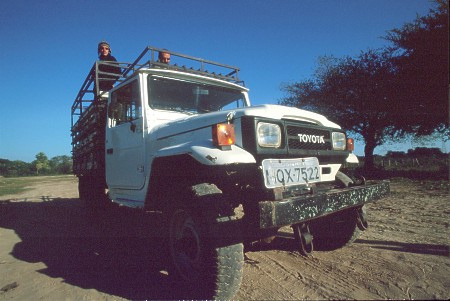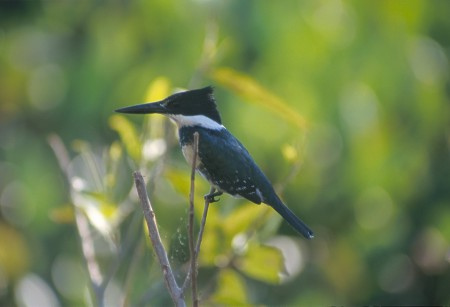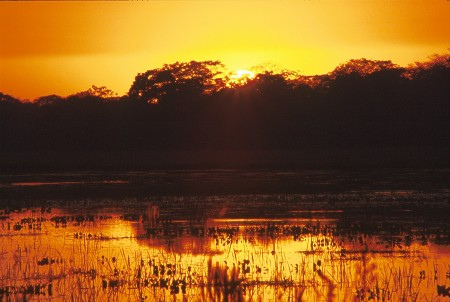Porto Murtinho
The stretch of the Paraguay River around Porto Murtinho is considered one of the best in Brazil for fishing. There's also a selection of Pantanal flora and fauna, although not as abundant or diverse as that further north. As with elsewhere in the Pantanal, the economy is primarily based on cattle ranching, but with tourism, agriculture, and the production of tannins for leather processing from quebracho hardwoods. The weather is quite warm, with heavy rainfall, mostly between October and January. During this period, the temperature reaches around 38°C. In the winter months (June/July), it drops to around 10°C.
History
Porto Murtinho owes its foundation to Maté Tea or Tereré. This is an important South American product which is consumed in vast quantities across Brazil, Paraguay, Uruguay and Argentina. The tea is made from the leaves of the Ilex paraguariensis (or Yerba Mate) plant, which contains caffeine (or mateine), and which was originally adopted as a beverage among the tupi and guarani indians of Paraguay and southern Brazil. The beverage also gained popularity among Europeans, being domesticated by the Jesuits and eventually became Paraguay's major export commodity - with much of the earnings going to Paraguay's ruling family and the state (which were effectively one and the same). This helped fund the Paraguayan rulers' Imperial ambitions leading up until War of Triple Alliance in 1864-70. After Paraguay's defeat, the Brazilian Emperor Dom Pedro II gave a concession for the production of maté to the trader Thomaz Larangeira for services rendered, leading to the formation of the company Companhia Matte Larangeira. Larangeira brought Paraguayan maté producers into the southern Pantanal region - using their knowledge to establish plantations on territory formerly belonging to the Kaiowá and Guarani indians, who provided much of the labour.
The production of maté in the area necessitated the establishment of a river port. Hence, Porto Murtinho was created by the company - being named in honour of Joaquim Murtinho, who was a Brazilian Minister of Finance, and also president of the Rio Branco e Matto Grosso Bank, through which the company obtained their funding. The company, and its successors, were also instrumental in the construction of local railroads to facilitate transport. However, production and administration was gradually shifted south to the state of Paraná, where the company also founded the town of Guaíra. One of the old locomotives (A 1905 model Orenstein-Koppel manufactured in Germany) remains preserved Porto Murtinho's central plaza.
Role in the 1932 Revolution
Porto Murtinho also featured briefly in Brazil's Constitutionalist Revolution of 1932. This occurred when the state of São Paulo and the southern region of Mato Grosso (now Mato Grosso do Sul) took up arms against the dictatorship of Brazilian president Getúlio Vargas. Porto Murtinho was a primary line of defence for the rebels to protect against incursions by Brazilian federal forces. However, the Brazilian Navy operating on the Paraguay river (and based in the naval port of Ladário, near Corumbá) managed to disrupt the rebels' supply shipments. As a result, the assault by federal forces was decisive. With few arms and almost no ammunition, the rebel forces were soon dispersed.
Things to See and Do
Castelinho
Rua Doutor Correia , 456
This "castle" (its actually just an old brick building with a turrent) was built by a local businessman as a means to persuade his European wife to remain in Porto Murtinho. Her demand was that he build a European-style castle so she didn't feel homesick for Europe. It was a local marvel when it was built, in the late 19th century, featuring ts own electricity, running water and furnishings were imported in the Old Continent .
Ilha da Margarida
This is a Free Trade Zone, is on the Paraguayan side of the river. The best to get there is by taking a chalana (small boat or ferry) across the Paraguay River from the local port. Its hardly a shopper's paradise, but goods are cheaper than in Brazil. Brazilians can purchase up to USD150 tax-free. International visitors shouldn't have much problem with customs if your intention is to take the goods with you once you leave Brazil.
Hotels
Below are links to several local hotels.
Name
Description
Hotel dos Camalotes
Fazenda Três Barras, Rua. Dr. Costa Marques. Approx 1.5km from the town centre
www.hoteldoscamalotes.com.br
Located on the banks of the Paraguay River. Like other hotels in the region this caters primarily to fishing tours. Also has links ti the Barco-Hotel Potosi.
Pousada Foz do Rio Apa
Fazenda Jaguatirica. 56km from Porto Murtinho. Access by dirt road.
www.pousadafozdorioapa.com.br
Fishing lodge based in Colonia Ingazeira rural locality outside Porto Murtinho. No reviews. Little or no English spoken
Ranchos Porto Murtinho
Location
www.ranchosportomurtinho.com.br
Two pousadas in the Porto Murtinho area: Rancho Casa Branca, and Rancho Casa Verde.
Hotel Saladero Cue
Fazenda Saladero, Rua Pedro Celestino. Approx 1.5km from the town centre
www.hotelsaladerocue.com.br
One of few hotel options in town. Sorro, no reviews. Website available only intermittently. Alternatively phone (67) 3287-1113. Has links with a fishing lodge called Sonho do Nablique.
Barco-Hotels
Below are links to several Barco-Hotels operating out of Porto Murtinho. These are primarily aimed at fishing holiday being offered to Brazilian fishermen, so there's no guarantee that English will be spoken. These trips generally last several days - fishing in various Pantanal locations with catch and release being encouraged. Note that there's no fishing during the spawning (piracema) period Nov-Feb. A fishing licence will also be needed, although most companies can help make the arrangements for you.
Name
Description
Barco-Hotel Hannah
Praça Thomas Laranjeiras
www.hannah.com.br
Barco-Hotel with room for up to 14 people, operating out of Porto Murtinho.
Fênix Tour
Rua Tetente Antônio João
www.fenixtour.com.br
Operators of three barco-hotels, the Gold Fish, Millenium and Eco-Fishing, based in Porto Murtinho.
Getting There and Away
Air: Porto Murtinho is a very small town without scheduled air services, but there's a small airfield for access by private and charter flights.
Road: The town is 415km from Campo Grande, and can be reached via Aquidauana on BR-262, travelling on BR-419 to Nioaque and Jardim, then on BR-267 to Porto Murtinho.
Bus: From Campo Grande, Viação Cruzeiro do Sul runs two buses daily to Porto Murtinho. The trip takes around 7 hours.








Photo Credits: Spectacled Caiman (Shutterstock/Dirk Ercken)
Pantanal Escapes